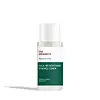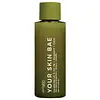What's inside
What's inside
 Key Ingredients
Key Ingredients

 Benefits
Benefits

 Concerns
Concerns

 Ingredients Side-by-side
Ingredients Side-by-side

Water
Skin ConditioningButylene Glycol
HumectantGlycerin
Humectant1,2-Hexanediol
Skin ConditioningHydroxyacetophenone
AntioxidantPanthenol
Skin ConditioningDiglycerin
HumectantPaeonia Suffruticosa Root Extract
Skin ProtectingGlycyrrhiza Uralensis Root Extract
Skin ConditioningPortulaca Oleracea Flower/Leaf/Stem Extract
AntioxidantPaeonia Lactiflora Extract
AstringentAllantoin
Skin ConditioningAdenosine
Skin ConditioningTremella Fuciformis Polysaccharide
Emulsion StabilisingPropylene Glycol
HumectantPEG-40 Hydrogenated Castor Oil
EmulsifyingSodium Hyaluronate
HumectantMaltodextrin
AbsorbentPhenoxyethanol
PreservativeCentella Asiatica Leaf Extract
Skin ConditioningCaprylic/Capric Triglyceride
MaskingMadecassoside
AntioxidantHydrogenated Lecithin
EmulsifyingEthylhexylglycerin
Skin ConditioningHexylene Glycol
EmulsifyingStearic Acid
CleansingCholesterol
EmollientCeramide NP
Skin ConditioningAsiaticoside
AntioxidantCeramide EOP
Skin ConditioningCeramide As
Skin ConditioningCeramide AP
Skin ConditioningCeramide Ng
Skin ConditioningBisabolol
MaskingCaramel
Cosmetic ColorantZingiber Officinale Root Extract
MaskingCI 19140
Cosmetic ColorantCI 42090
Cosmetic ColorantWater, Butylene Glycol, Glycerin, 1,2-Hexanediol, Hydroxyacetophenone, Panthenol, Diglycerin, Paeonia Suffruticosa Root Extract, Glycyrrhiza Uralensis Root Extract, Portulaca Oleracea Flower/Leaf/Stem Extract, Paeonia Lactiflora Extract, Allantoin, Adenosine, Tremella Fuciformis Polysaccharide, Propylene Glycol, PEG-40 Hydrogenated Castor Oil, Sodium Hyaluronate, Maltodextrin, Phenoxyethanol, Centella Asiatica Leaf Extract, Caprylic/Capric Triglyceride, Madecassoside, Hydrogenated Lecithin, Ethylhexylglycerin, Hexylene Glycol, Stearic Acid, Cholesterol, Ceramide NP, Asiaticoside, Ceramide EOP, Ceramide As, Ceramide AP, Ceramide Ng, Bisabolol, Caramel, Zingiber Officinale Root Extract, CI 19140, CI 42090
Water
Skin ConditioningPropylene Glycol
HumectantGlycerin
HumectantCentella Asiatica Extract
CleansingPhenoxyethanol
PreservativeButylene Glycol
HumectantHydroxypropyl Bisstearamide Mea
Skin ConditioningPolyglutamic Acid
Skin ConditioningChlorphenesin
AntimicrobialBehenyl Alcohol
EmollientDipropylene Glycol
HumectantTetrasodium EDTA
Ascorbic Acid
AntioxidantCeteareth-20
CleansingCholesteryl Isostearate
EmollientTricaprylin
MaskingCetearyl Alcohol
Emollient1,2-Hexanediol
Skin ConditioningCholesterol
EmollientSqualane
EmollientArtemisia Princeps Leaf Extract
Skin ConditioningStearic Acid
CleansingDimethicone
EmollientSodium Hydroxide
BufferingWater, Propylene Glycol, Glycerin, Centella Asiatica Extract, Phenoxyethanol, Butylene Glycol, Hydroxypropyl Bisstearamide Mea, Polyglutamic Acid, Chlorphenesin, Behenyl Alcohol, Dipropylene Glycol, Tetrasodium EDTA, Ascorbic Acid, Ceteareth-20, Cholesteryl Isostearate, Tricaprylin, Cetearyl Alcohol, 1,2-Hexanediol, Cholesterol, Squalane, Artemisia Princeps Leaf Extract, Stearic Acid, Dimethicone, Sodium Hydroxide
Ingredients Explained
These ingredients are found in both products.
Ingredients higher up in an ingredient list are typically present in a larger amount.
1,2-Hexanediol is a synthetic liquid and another multi-functional powerhouse.
It is a:
- Humectant, drawing moisture into the skin
- Emollient, helping to soften skin
- Solvent, dispersing and stabilizing formulas
- Preservative booster, enhancing the antimicrobial activity of other preservatives
Butylene Glycol (or BG) is used within cosmetic products for a few different reasons:
Overall, Butylene Glycol is a safe and well-rounded ingredient that works well with other ingredients.
Though this ingredient works well with most skin types, some people with sensitive skin may experience a reaction such as allergic rashes, closed comedones, or itchiness.
Learn more about Butylene GlycolCholesterol is a class of organic molecules called lipids. It helps hydrate your skin and is essential to having a healthy skin barrier.
Our skin naturally contains cholesterol in the outermost layer. Besides cholesterol, it also contains ceramides and fatty acids. Cholesterol makes up about 1/4 of your skin's outer layer and barrier. Your skin barrier is responsible for keeping allergens and microbes out. Having a healthy skin barrier is also responsible for keeping your skin firm and plump.
Our bodies use cholestrol to create vitamin D, steroid hormones, and more.
Learn more about CholesterolGlycerin is already naturally found in your skin. It helps moisturize and protect your skin.
A study from 2016 found glycerin to be more effective as a humectant than AHAs and hyaluronic acid.
As a humectant, it helps the skin stay hydrated by pulling moisture to your skin. The low molecular weight of glycerin allows it to pull moisture into the deeper layers of your skin.
Hydrated skin improves your skin barrier; Your skin barrier helps protect against irritants and bacteria.
Glycerin has also been found to have antimicrobial and antiviral properties. Due to these properties, glycerin is often used in wound and burn treatments.
In cosmetics, glycerin is usually derived from plants such as soybean or palm. However, it can also be sourced from animals, such as tallow or animal fat.
This ingredient is organic, colorless, odorless, and non-toxic.
Glycerin is the name for this ingredient in American English. British English uses Glycerol/Glycerine.
Learn more about GlycerinPhenoxyethanol is a preservative that has germicide, antimicrobial, and aromatic properties. Studies show that phenoxyethanol can prevent microbial growth. By itself, it has a scent that is similar to that of a rose.
It's often used in formulations along with Caprylyl Glycol to preserve the shelf life of products.
Propylene Glycol is an odorless, colorless liquid. As a humectant, it helps skin retain moisture. It also aids in delivering active ingredients.
Another role of this ingredient is preventing a product from melting or freezing. Propylene glycol also adds antimicrobrial properties to a product, elongating product lifespan.
This ingredient is considered an organic alcohol and commonly added into both cosmetics and foods.
Those with sensitive skin or conditions may develop a rash when using this ingredient.
Learn more about Propylene GlycolStearic Acid is a fatty acid. It is an emollient, emulsifier, and texture enhancer.
As an emollient, stearic acid helps soften skin. It aids the skin's protective barrier by preventing water loss. It also provides a gentle cleansing effect without stripping away natural oils.
Stearic acid may also be used to enhance the texture of products. It can add volume and stabilize ingredients such as water and oil. This can help water and oil ingredients from separating.
Sources of stearic acid include animal or vegetable fats/oils such as coconut or shea. It can be naturally found in butter, cocoa butter, shea butter, vegetable fats, and animal tallow.
This ingredient may not be Malassezia folliculitis, or fungal-acne safe.
Learn more about Stearic AcidWater. It's the most common cosmetic ingredient of all. You'll usually see it at the top of ingredient lists, meaning that it makes up the largest part of the product.
So why is it so popular? Water most often acts as a solvent - this means that it helps dissolve other ingredients into the formulation.
You'll also recognize water as that liquid we all need to stay alive. If you see this, drink a glass of water. Stay hydrated!
Learn more about Water